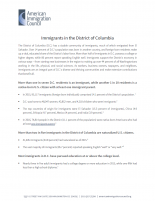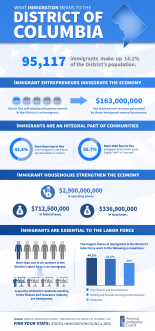- Fact Sheet
Immigrants in the District of Columbia
The District of Columbia (D.C.) has a sizable community of immigrants, many of whom emigrated from El Salvador. Roughly 14 percent of D.C.’s population was born in another country and foreign-born residents make up a vital, educated share of the District’s labor force. Nearly three-fifths of immigrants in D.C. possess a college or higher degree, while more than four-fifths report speaking English well.
Immigrants support the D.C. economy in various ways—from starting new businesses in the region to making up more than a quarter of all Washingtonians working in the life, physical, and social sciences. As neighbors, business owners, taxpayers, and workers, immigrants are an integral part of D.C.'s diverse and thriving communities and make extensive contributions that benefit all.
One in seven D.C. residents is an immigrant, while about one in nine residents is a native-born U.S. citizen with at least one immigrant parent.
- In 2018, 97,846 immigrants (foreign-born individuals) comprised 14 percent of the population.
- D.C. was home to 50,612 women, 40,673 men, and 6,561 children who were immigrants.
- The top countries of origin for immigrants were El Salvador (11 percent of immigrants), Ethiopia (7 percent), Mexico (3 percent), Trinidad & Tobago (3 percent), and China (3 percent).
- In 2018, 75,363 people in D.C. (11 percent of the population) were native-born Americans who had at least one immigrant parent.
More than two-fifths of all immigrants in D.C. are naturalized U.S. citizens.
- 44,289 immigrants (45 percent) had naturalized as of 2018, and 21,952 immigrants were eligible to become naturalized U.S. citizens in 2017.
- More than four in five (86 percent) of immigrants reported speaking English “well” or “very well.”
Immigrants in D.C. tend to be college educated.
- Nearly three-fifths (58 percent) of adult immigrants had a college degree or more education in 2018, while fewer than one-fifth (18 percent) had less than a high school diploma.
|
Education Level |
Share (%) of All Immigrants |
Share (%) of All Natives |
|---|---|---|
|
College degree or more |
58 |
61 |
|
Some college |
12 |
16 |
|
High school diploma only |
12 |
17 |
|
Less than a high school diploma |
18 |
6 |
|
Source: U.S. Census Bureau, 2018 American Community Survey 1-Year Estimates. |
||
More than 10,000 U.S. citizens in D.C. live with at least one family member who is undocumented.
- 25,000 undocumented immigrants comprised 28 percent of the immigrant population and 4 percent of the total state population in 2016.
- 23,979 people in D.C., including 10,482 U.S. citizens, lived with at least one undocumented family member between 2010 and 2014.
- During the same period, about 7 percent of children in D.C. were U.S. citizens living with at least one undocumented family member (7,572 children in total).
D.C. is home to hundreds of Deferred Action for Childhood Arrivals (DACA) recipients.
- 600 active DACA recipients lived in D.C. as of March 2020, while DACA has been granted to 738 people in total since 2012.
- As of 2019, 29 percent of DACA-eligible immigrants in D.C. had applied for DACA.
- Fewer than 1,000 residents of D.C. would satisfy all but the educational requirements for DACA, and fewer than 1,000 would become eligible as they grew older.
One in six D.C. workers is an immigrant, making up a vital part of the labor force.
- 68,114 immigrant workers comprised 17 percent of the labor force in 2018.
- Immigrant workers were most numerous in the following industries:
|
Industry |
Number of Immigrant Workers |
|---|---|
|
Professional, Scientific, and Technical Services |
13,114 |
|
Public Administration |
9,811 |
|
Accommodation and Food Services |
9,156 |
|
Health Care and Social Assistance |
8,493 |
|
Other Services (except Public Administration) |
7,585 |
|
Source: Analysis of the U.S. Census Bureau’s 2018 American Community Survey 1-year PUMS data by the American Immigration Council. |
|
- The largest shares of immigrant workers were in the following industries:
|
Industry |
Immigrant Share (%) |
|---|---|
|
Mining, Quarrying, and Oil & Gas Extraction |
100 |
|
Accommodation and Food Services |
25 |
|
Administrative & Support; Waste Management; and Remediation Services |
23 |
|
Construction |
23 |
|
Finance and Insurance |
20 |
|
Source: Analysis of the U.S. Census Bureau’s 2018 American Community Survey 1-year PUMS data by the American Immigration Council. |
|
Immigrants are an integral part of the D.C. workforce in a range of occupations.
- In 2018, immigrant workers were most numerous in the following occupation groups:
|
Occupation Category |
Number of Immigrant Workers |
|---|---|
|
Management |
9,395 |
|
Business and Financial Operations |
7,492 |
|
Building and Grounds Cleaning & Maintenance |
5,723 |
|
Arts, Design, Entertainment, Sports, and Media |
5,206 |
|
Life, Physical, and Social Science |
4,758 |
|
Source: Analysis of the U.S. Census Bureau’s 2018 American Community Survey 1-year PUMS data by the American Immigration Council. |
|
- The largest shares of immigrant workers were in the following occupation groups:
|
Occupation Category |
Immigrant Share (%) |
|---|---|
|
Building and Grounds Cleaning & Maintenance |
42 |
|
Healthcare Support |
40 |
|
Life, Physical, and Social Science |
29 |
|
Construction and Extraction |
22 |
|
Installation, Maintenance, and Repair |
22 |
|
Source: Analysis of the U.S. Census Bureau’s 2018 American Community Survey 1-year PUMS data by the American Immigration Council. |
|
- Undocumented immigrants comprised 5 percent of the District of Columbia’s workforce in 2016.
Immigrants in D.C. have contributed over a billion dollars in taxes.
- Immigrant-led households in D.C. paid $931.8 million in federal taxes and $416.9 million in state and local taxes in 2018.
- Undocumented immigrants in D.C. paid an estimated $48.7 million in federal taxes and $23.1 million in state and local taxes in 2018.
- D.C. DACA recipients and DACA-eligible individuals paid an estimated $3.1 million in state and local taxes in 2018.
As consumers, immigrants add billions of dollars to the D.C. economy.
- D.C. residents in immigrant-led households had $3 billion in spending power (after-tax income) in 2018.
Immigrant entrepreneurs in D.C. generate tens of millions of dollars in business revenue.
- 5,452 immigrant business owners accounted for 16 percent of all self-employed D.C. residents in 2018 and generated $145 million in business income.
- In 2018, immigrants accounted for 31 percent of business owners in the greater Washington metropolitan area (which spans D.C., Maryland, and Virginia).


